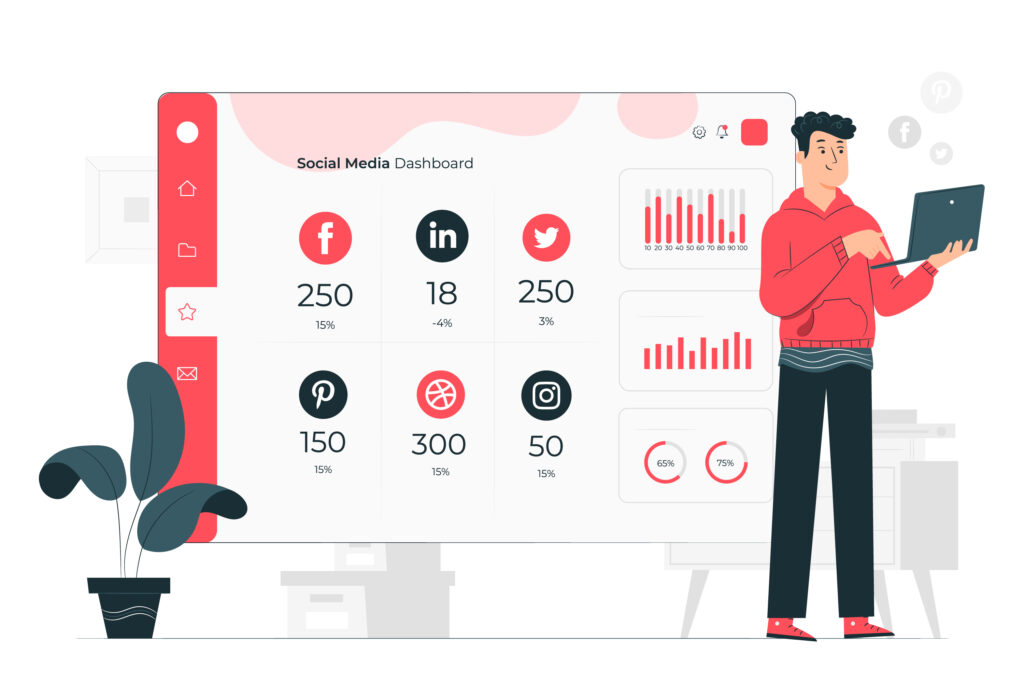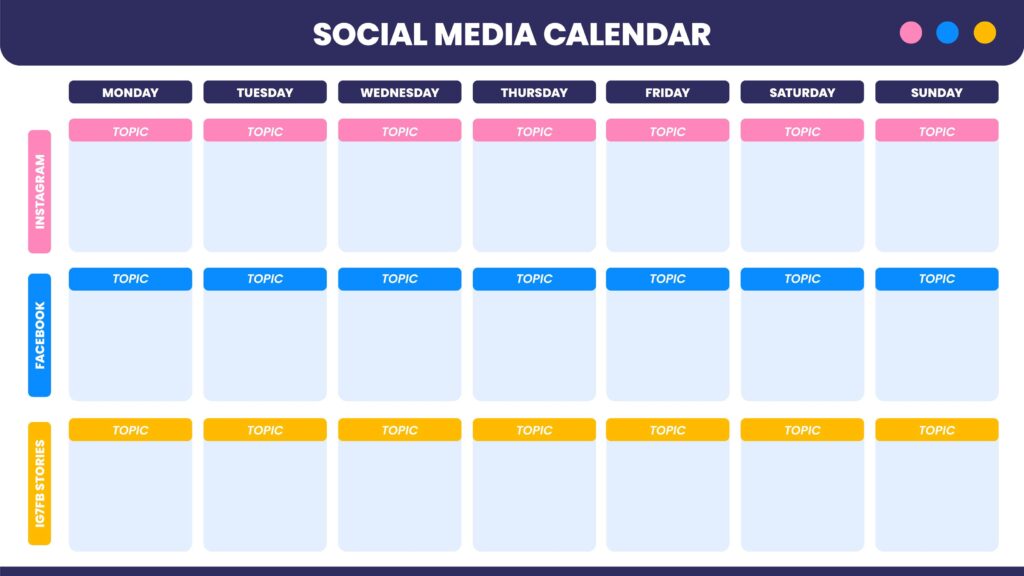In today’s super-fast digital world, it’s very important for businesses and brands to create a social media content calendar. But, how to create a social media content calendar? Basically, this is just a fancy way of saying a plan that shows what and when you will post on your social media. This plan helps you stay organized, keep things consistent, and connect with your audience in the best way possible.
In this guide, we will talk about why having a social media content calendar is so important and give you some easy steps to make one that works for you and your audience.
What Is a Social Media Content Calendar?
A social media calendar is basically a super helpful tool that gives you a sneak peek into all the posts you’re planning to put up on social media. This calendar is usually sorted by date and time and can come in many forms like a document, spreadsheet, or cool interactive dashboard. Social media marketers use these content calendars to plan posts, manage campaigns, and review ongoing strategies for their clients.
When you make a social media calendar, it usually has three main parts:
- The creatives that you’re going to post (like a copy, image files, videos, links, tags, etc.)
- Date and time
- The social media platform and account where it will be posted.
This calendar is super useful if you are handling a bunch of social media accounts on Instagram, Facebook, LinkedIn, and Twitter. With a social media content calendar, you can keep your brand’s vibe real and unique, and you can plan out different versions of each post so you can make sure everything’s on point. Plus, you can make smart choices about what kind of stuff you want to share on each account.
How to Create a Social Media Content Calendar for in 6 Easy Steps
1. Understanding Your Target Audience
Before you start creating your content calendar, you must have a deep understanding of your target audience for social media. This involves knowing their demographics, preferences, pain points, and online behavior. Conduct audience research through surveys, social media analytics, and market research to gather valuable insights.
Tips on Conducting Audience Research:
Demographics
Begin by gathering basic demographic information such as age, gender, location, and income. This helps in tailoring content to suit the characteristics of your audience.
Social Media Behavior
Analyze how your target audience uses various social media platforms. Are they more active on Facebook, Instagram, Twitter, or other networks? Knowing their preferences helps you allocate resources effectively.
Competitor Analysis
Study your competitors’ social media presence. What type of content engages their audience? What strategies are they employing? This can provide valuable clues about your own audience’s preferences.
2. Setting Your Social Media Goals
Once you have a clear understanding of your audience, the next step is setting specific goals for your social media content. The goals you set act as guiding stars that guide your content strategy.
Examples of Common Social Media Goals
Increasing Brand Awareness
If you’re a new brand or looking to expand your reach, your goal might be to increase your social media followers and create a buzz around your products or services.
Driving Website Traffic
If your primary aim is to funnel traffic to your website, focus on creating content that includes links to your site. You can measure success through website analytics.
Boosting Engagement
Engagement encompasses likes, comments, shares, and other interactions with your content. A goal here could be to increase these metrics, indicating that your content is resonating with your audience.
Enhancing Customer Loyalty
Building a loyal online community can be a valuable goal. It involves nurturing relationships with existing customers and creating content that keeps them engaged and committed to your brand.
3. Choosing the Right Platforms
Not all social media platforms are created equal. Each has its unique user base and communication style. The key is to identify the platforms that align with your brand and target audience.
Know Your Audience
Refer back to your audience research. If your target demographic primarily consists of young adults, platforms like Instagram and TikTok may be more relevant. For a professional audience, LinkedIn might be the go-to platform.
Understand Platform Features
Familiarize yourself with the features and functionalities of each platform. Instagram is highly visual, Twitter is known for brevity, and Facebook offers a variety of content formats. Tailor your content accordingly.
Platform-Specific Content
Each platform has its own content norms. For example, Instagram thrives on visually appealing images and short videos, while Twitter relies on concise text and trending hashtags. Ensure your content suits the platform.
4. Plan What Kind of Content to Post
Having identified your audience, set your goals, and choose your platforms, it’s time to brainstorm and generate content ideas. Content is the lifeblood of your social media strategy, and it needs to be engaging, informative, and relevant.
Tips on Generating Content Ideas
Content Calendar Themes
Establish monthly or quarterly themes for your content calendar. This helps maintain consistency and gives your audience something to look forward to.
Trending Topics
Keep an eye on trending topics and hashtags within your niche. Joining conversations around these trends can increase your visibility.
Educational Content
Share informative and educational content that addresses common questions or challenges faced by your audience. How-to guides, tutorials, and infographics are effective in this regard.
Interactive Content
Polls, quizzes, contests, and interactive stories can boost engagement and encourage user participation.
5. Schedule Your Posts
Creating fantastic content is just one part of the equation; timing plays a crucial role in social media success. Scheduling your posts strategically maximizes reach and engagement.
Use Scheduling Tools
Invest in social media management tools like Buffer, Hootsuite, or Later to schedule your posts in advance. These tools also provide analytics and insights.
Consider Time Zones
If your audience spans different time zones, schedule posts to accommodate the majority of your followers. This ensures that your content is visible to as many people as possible.
6. Monitoring and Analytics on Published Content
Monitoring and analyzing your published content is crucial for refining your social media strategy. Here’s how to go about it:
Track Key Metrics
Pay attention to engagement metrics such as likes, comments, shares, click-through rates, and conversions. Analyze these metrics to gauge the effectiveness of your posts.
Assess Audience Behavior
Dive into analytics tools provided by social media platforms or third-party software to understand when your audience is most active, what type of content they prefer, and which posts perform best.
Measure ROI
If your social media goals include sales or lead generation, track the return on investment (ROI) by monitoring the conversion rates and revenue generated through your social media efforts.
Benefits of Using a Social Media Content Calendar
Streamline Social Media Strategy and Save Time
A content calendar streamlines your social media strategy by eliminating the need for last-minute content creation. This saves you time and reduces stress, allowing you to focus on creating high-quality content.
Maintain a Consistent Social Media Posting Plan
Consistency is key to building a strong online presence. A content calendar ensures you have a steady stream of content going out, keeping your audience engaged and informed.
Enhance Your Content Strategy
With a content calendar, you can plan your content strategically. This means aligning your posts with current events, holidays, and industry trends to make your content more relevant and shareable.
Improve Your Social Media Management Weaknesses
Monitoring the performance of your scheduled posts allows you to identify areas where your social media strategy may be falling short. You can then make adjustments to address these weaknesses and improve your overall strategy.
Streamline Cross-Functional Collaboration
If multiple team members are involved in your social media efforts, a content calendar ensures everyone is on the same page. It helps with coordination, reduces duplication of efforts, and ensures a consistent brand voice across all platforms.
Social Media Content Calendar Template and Tools
Google Calendar
Google Calendar is a simple and free tool that can be used for creating a content calendar. You can create events for each social media post and set reminders.
Microsoft Excel or Google Sheets
As demonstrated in the template above, spreadsheets can be a straightforward way to create a content calendar. You can customize the columns to fit your requirements.
Buffer
Buffer is a popular social media management tool that includes a content calendar feature. It allows you to schedule posts, track performance, and collaborate with team members.
Hootsuite
Hootsuite is another well-known social media management platform that offers a content calendar for scheduling and managing posts across various social networks.
Social Media Analytics Tools
Platforms like Facebook, Instagram, and Twitter offer built-in analytics tools that provide detailed insights into your audience’s behavior, demographics, and post-performance.
Wrapping Up
In the ever-evolving world of digital marketing, a social media content calendar is your secret weapon for success. It empowers you to plan, organize, and execute your social media strategy effectively. By understanding your audience, setting clear goals, choosing the right platforms, diversifying your content, scheduling posts strategically, and monitoring performance, you can optimize your social media efforts and achieve your marketing objectives. So, don’t delay—start planning your social media content calendar today, and watch your online presence thrive.
FAQs on How to Create a Content Calendar for Social Media
What are the key elements of a content calendar?
Key elements of a content calendar include posting schedule, content type, topics/themes, keywords/hashtags, platforms, responsible team members, status, and performance metrics.
How do I plan a content calendar on Instagram?
Plan an Instagram content calendar by defining your themes, deciding on posting frequencies, scheduling posts using Instagram’s built-in tools or third-party apps, and tracking your performance.
How do I create a content calendar in Canva?
To create a content calendar in Canva, open Canva, search for “Calendar,” choose a template, customize it, and add your content and dates.





